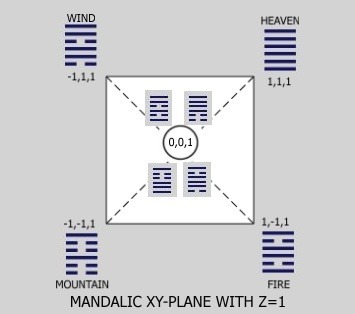#inversion
My first workshop yogis!!!
¤
Intro to Arm Balance and Inversions
with Crio and Lisette
Saturday, June 18th at @yogaloft_vaughan
2-3pm
($40)
Ever wanted to take your practice to the next level?
This workshop will help you get acquainted with arm balances and inversion poses.
Crio and Lisette will show you different ways and variations that can assist you from doing these asanas and incorporating them in your daily practice.
Fear of the unknown is one of the biggest obstacles that stand in the way of people trying new and invigorating poses.
Together, we will show you the proper way and correct alignment on how to perform these asanas so you can develop the confidence and strength to attempt them. You will learn techniques that will help you practice them on your own!
This workshop is suitable for all levels of practitioners but regular yoga practice is encouraged.
Get upside down with us and sign up now!
.
.
Hope to see you guys there!
#yoga #yogawithcrio
#yogalove #yogagirl
#yogaeverydamnday #torontoyoga
#torontoyogi #Toronto #brampton
#vaughan #yogapractice
#armbalance #workshop #inversion
#namaste
Post link
Neo-Boolean - II: Logic Gates
Thinking Inside the Lines

(continued from here)
We have already looked briefly at three of the more important Boolean operators or logic gates: AND, OR,andXOR.NOT just toggles any two Boolean truth values (true/false; on/off; yes/no). Here we introduce two new logic gates which do not occur in Boolean algebra. Both play an important role in mandalic geometry though.
We’ll refer to the first of these new operators or logic gates as INV standing for inversionorinvert. This is similar to Boole’s NOT except that it produces toggling betweeen yang/+ and yin/- instead of 1 and 0. Because it is based on binary arithmetic, Boole’s NOT has been thought of as referring to inversion also (as in ONorOFF). Although both ANDandINV act as toggling logic gates they have very different results in the greater scheme of things, since nature has created a prepotent disparity between a -/+ toggle and a 0/1 toggle in basic parameters of geometry, spacetime, and being itself. This makes Boole’s AND just a statement of logical opposition, notinversion.
Recognition of this important difference is built into mandalic geometry structurally and functionally, as it is also into Cartesian coordinate dynamics and the logic of the I Ching, but lacking in Boole’s symbolic logic. This is necessarily so, as there is no true negative domain in Boolean algebra. The OFF state of electronics and computers, though it may sometimes be thought of in terms of a negative state, is in fact not. It relates to the Western zero (0), not the minus one of the number line. Where Boolean algebra speaks of NOT 1 it refers specifically to zero and only to zero. When mandalic geometry asserts INV 1 it refers specifically to -1 and only to -1 . The inversion of yang then is yin and the inversion of yinisyang.[1] In the I Ching, Taoist thought, and mandalic geometry the two are not opposites but complements and, as such, interdependent.
The second added logic gate that will be introduced now is the REV operator standing for reversionorrevert. This operator produces no change in what it acts upon. It is the multiplicative identity element (also called the neutral elementorunit element), as INV is the inverse element. In ordinary algebra the inverse element is -1, while the identity element is 1. In mandalic geometry and the I Ching the counterparts are yinandyang, respectively. If Boolean algebra lacks a dedicated identity operator, it nonetheless has its Laws of Identity which accomplish much the same in a different way:
- A = A
- NOT A = NOT A
Again, Boolean algebra has no true correlate to the INV operator. There can be no sign inversion formulation as it lacks negatives entirely. Although Boolean algebra may have served analog and digital electronics and digital computers quite well for decades now, it is incapable of doing the same for any quantum logic applications in the future, if only because it lacks a negative domain.[2] It offers up bits readily but qubits only with extreme difficulty and those it does are like tears shed by crocodiles while feeding.
(to be continued)
Image: Boolean Search Operators. [Source]
Notes
[1] Leibniz’s binary number system, on which Boole based his logic, escapes this criticism, as Leibniz uses 0 and 1 simply as notational symbols in a modular arithmetic and not as contrasting functional elements in an algebraic context of either the Boolean or ordinary kind.
In the field of computers and electronics, Boolean refers to a data type that has two possible values representing true and false. It is generally used in context to a deductive logical system known as Boolean Algebra. Binary in mathematics and computers, refers to a base 2 numerical notation. It consists of two values 0 and 1. The digits are combined using a place value structure to generate equivalent numerical values. Thus, both are based on the same underlying concept but used in context to different systems. [Source]
[2] Moreover, I expect physics will soon enough discover that what it now calls antimatter is in some sense and to some degree a necessary constituent of ordinary matter. I can already hear the loudly objecting voices declaring matter and antimatter in contact necessarily annihilate one another, but that need not invalidate the thesis just proposed. My supposition revolves around the meaning of “contact” at Planck scale and the light speed velocity at which subatomic particles are born, interact and decay only to be revived again in an eternal dance of creation and re-creation. Material particles exist in some kind of structural and functional homeostasis, not all that unlike the anabolic and catabolic mechanisms that by means of negative feedback maintain all entities of the biological persuasion in the steady state we understand as life. Physics has yet to get a full grip on this aspect of reality, though moving ever closer with introduction of quarks and gluons to its menagerie of performing particles.
© 2016 Martin Hauser
Please note: The content and/or format of this post may not be in finalized form. Reblog as a TEXT post will contain this caveat alerting readers to refer to the current version in the source blog. A LINK post will itself do the same. :)
Scroll to bottom for links to Previous / Next pages (if existent). This blog builds on what came before so the best way to follow it is chronologically. Tumblr doesn’t make that easy to do. Since the most recent page is reckoned as Page 1 the number of the actual Page 1 continually changes as new posts are added. To determine the number currently needed to locate Page 1 go to the most recent post which is here. The current total number of pages in the blog will be found at the bottom. The true Page 1 can be reached by changing the web address mandalicgeometry.tumblr.com to mandalicgeometry.tumblr.com/page/x, exchanging my current page number for x and entering. To find a different true page(p) subtract p from x+1 to get the number(n) to use. Place n in the URL instead of x (mandalicgeometry.tumblr.com/page/n) where
n = x + 1 - p. :)
-Page 304-
Earlier to Later Heaven: Fugue VII Beyond Descartes - Part 2
A Different Zero


(continued from here)
Mandalic geometry has been formulated in such a manner as to be fully commensurate with Descartes’ coordinate system. Firstly, because it can be. Beyond that, because Descartes’ system is known throughout the world, and is endorsed by all conversant in disparate fields of science and mathematics. Moreover, the Cartesian coordinate system is a special case of the mandalic coordinate system, bearing a relationship to it analogous to that which Newtonian mechanics does to quantum mechanics.
One of the fundamental differences lies in the way the two regard zero locations. Descartes, taking his cue from the Western number line, constructs a coordinate system which envisages a single common origin to all three dimensions, while maintaining between those dimensions a rigid uncompromising distinction. Mandalic geometry views dimension as primary rather than points, lines, or two or three dimensional figures. It does not regard dimensions as intrinsically separate in the manner in which they exist and relate to one another. This allows for a far greater degree of flexibility of what we view as parts of the system, including the possibility of folding each into another, through different dimensions as well as the same dimension.
For Descartes, zero is the empty location, the no man’s land where positive and negative vectors of each dimension invert or fail to invert. A negative vector acting on a positive vector or another negative vector will cause inversion. A positive vector, acting on a negative vector or another positive vector, will not. For mandalic geometry, zeros are that, but more. They are dimension interchange lanes, and also locations of dimensional amplitudetransition.[1]
Descartes, influenced still by the number line, proceeds to build a geometric universe based largely on scale. It is an imposing edifice nearly purely divergent, constructed from three largely independent linear axes of evolutionary zeal. Taoist cosmology and mandalic coordinates equally eschew an impressive but mundane number line in pursuance of complex twisting and intertwining of parts evolved on the underlying principles of modularity, repetition, reflection, relationship and recursion.[2]
These are two very different universes of logic. Descartes’ approach leads to a description of space as being homogenous, isotropic, and fixed while that of mandalic geometry leads alternatively to a spacetime which is inhomogeneous, anisotropic and dynamically variable.[3] For Descartes space is a background arena, the theater in which all events transpire.[4] For mandalic geometry, space-time is foreground and background both. It is the sole ground which defines the nature of reality.
(continuedhere)
Notes
[1] The first, dimensional interchanges, occur in the Cartesian coordinate system but are generally neither recognized nor treated as such. Dimensional amplitude transition locations do not occur in Cartesian coordinates, nor are they found in the simple 3D trigram Cartesian equivalent, reproduced in the upper diagram above, as they are a manifestation only of compositing of two or more dimensions. They are attributes of all hybrid composite dimensional systems, for our purposes here, either the 6D/3D hybrid mandalic system of hexagrams, the 4D/2D hybrid mandalic system of tetragrams, or the 2D/1D hybrid mandalic system of bigrams.
[2] An important consequence here is that Descartes’ number line-based axes each contain a single zero. When mandalic coordinates are scaled up beyond the basic modular unit, every even number maintains all characteristics of the initial zero, including, most significantly, its multipotentiality. This is a basic axiomatic result of the intermingling, sharing nature of mandalic structure.
[3] It is this variability and dynamism of mandalic coordinates that make the method potentially suitable to mappings of subatomic particles as these are similarly variable and dynamic, sharing importantly also the ability of exchanges / interchanges among their diverse numbers.
[4] Witness for example how Descartes exploits his newly formed coordinate system to stage, what was then, a cutting-edge geometric exposition of algebra, now referred to as analytic geometry. Mandalic geometry employs coordinates which are pre-invested with the ability to directly impart information regarding spatial transmutations themselves, without requirement of any intermediary.
© 2015 Martin Hauser
Please note: The content and/or format of this post may not be in finalized form. Reblog as a TEXT post will contain this caveat alerting readers to refer to the current version in the source blog. A LINK post will itself do the same. :)
Scroll to bottom for links to Previous / Next pages (if existent). This blog builds on what came before so the best way to follow it is chronologically. Tumblr doesn’t make that easy to do. Since the most recent page is reckoned as Page 1 the number of the actual Page 1 continually changes as new posts are added. To determine the number currently needed to locate Page 1 go to the most recent post which is here. The current total number of pages in the blog will be found at the bottom. The true Page 1 can be reached by changing the web address mandalicgeometry.tumblr.com to mandalicgeometry.tumblr.com/page/x, exchanging my current page number for x and entering. To find a different true page(p) subtract p from x + 1 to get the number(n) to use. Place n in the URL instead of x (mandalicgeometry.tumblr.com/page/n) where
n = x + 1 - p. :)
-Page 278-
Beyond the Enlightenment Rationalists:
From imaginary to probable numbers - IV

(continued from here)
One of the notable things the Rationalists failed to take into account in their analysis and codification of square roots was the significance of context. In so doing they assured that all related concepts they developed would eventually degenerate into a series of errors of conflation. Do not ever underestimate the importance of context.
Mathematicians, for example, can show that for any 3-dimensional cube there exists a 2-dimensional square, the area of which equals the volume of the cube.[1] And although that is true, something has been lost in translation. This is another of the sleights of hand mathematicians are so fond of. Physicists cannot afford to participate in such parlor tricks as these, however mathematically true they might be.[2]
We will begin now, then, to examine how the mandalic coordinate approach stacks up against that of imaginary numbers and quaternions. The former are holistic and respective of the natural order; the latter are irresponsibly rational, simplistic and, in final analysis, wrong about how nature works.[3] Ambitious endeavor indeed, but let’s give it a go.
We’ve already looked at how the standard geometric interpretation of imaginary numbers in context of the complex plane is based on rotations through continuous Euclidean space. You can brush up on that aspect of the story here if necessary. The mandalic approach to mapping of space is more complicated and far more interesting. It involves multidimensional placement of elements in a discrete space, which is to say a discontinuous space, but one fully commensurate with both Euclidean and Cartesian 3-dimensional space. The holo-interactive manner in which these elements relate to one another leads to a probabilistic mathematical design which preserves commutative multiplication, unlike quaternions which forsake it.
Transformations between these elements are based on inversion (reflection through a point) rather than rotation which cannot in any case reasonably apply to discrete spaces. The spaces that quantum mechanics inhabits are decidedly discrete. They cannot be accurately detailed using imaginary and complex numbers or quaternions. To discern the various, myriad transitions which can occur among mandalic coordinates requires some patience. I think it cannot be accomplished overnight but at least in the post next up we can make a start.[4]
(continuedhere)
Image: A drawing of the first four dimensions. On the left is zero dimensions (a point) and on the right is four dimensions (A tesseract). There is an axis and labels on the right and which level of dimensions it is on the bottom. The arrows alongside the shapes indicate the direction of extrusion. By NerdBoy1392 (Own work) [CC BY-SA 3.0orGFDL],via Wikimedia Commons
Notes
[1] If only in terms of scalar magnitude. Lost in translation are all the details relating to vectors and dimensions in the original. Conflation does not itself in every case involve what might be termed ‘error’ but because it always involves loss or distortion of information, it is nearly always guaranteed to eventuate in error somewhere down the line of argument. The point of all this in our context here is that, in the history of mathematics, something of this sort occurred when the Rationalists of the Enlightenment invented imaginary and complex numbers and again when quaternions were invented in 1843. These involved a disruption of vectors and dimensions as treated by nature. The loss of information involved goes a long way in explaining why no one has been able to explain whyandhow quantum mechanics works in a century or more. These misconstrued theses of mathematics behave like a demon or ghost in the machine that misdirects, albeit unintentionally, all related thought processes. What we end up with is a plethora of confusion. The fault is not in quantum mechanics but in ourselves, that we are such unrelentingly rational creatures, that so persistently pursue an unsound path that leads to reiterative error.
[2] Because physicists actually care about the real world; mathematicians, not so much.
[3] It must be admitted though that it was not the mathematicians who ever claimed imaginary numbers had anything to do with nature and the real world. Why would they? Reality is not their concern or interest. No, it was physicists themselves who made the mistake. The lesson to be learned by physicists here I expect is to be careful whose petticoat they latch onto. Not all are fabricated substantially enough to sustain their thoughts about reality, though deceptively appearing to do just that for protracted periods of time.
[4] My apologies for not continuing with this here as originally intended. To do so would make this post too long and complicated. Not that transformations among mandalic coordinates are difficult to understand, just that they are very convoluted. This is not a one-point-encodes-one-resident-number plan like that of Descartes we’re talking about here. This is mandala country.
© 2016 Martin Hauser
Please note: The content and/or format of this post may not be in finalized form. Reblog as a TEXT post will contain this caveat alerting readers to refer to the current version in the source blog. A LINK post will itself do the same. :)
Scroll to bottom for links to Previous / Next pages (if existent). This blog builds on what came before so the best way to follow it is chronologically. Tumblr doesn’t make that easy to do. Since the most recent page is reckoned as Page 1 the number of the actual Page 1 continually changes as new posts are added. To determine the number currently needed to locate Page 1 go to the most recent post which is here. The current total number of pages in the blog will be found at the bottom. The true Page 1 can be reached by changing the web address mandalicgeometry.tumblr.com to mandalicgeometry.tumblr.com/page/x, exchanging my current page number for x and entering. To find a different true page(p) subtract p from x+1 to get the number(n) to use. Place n in the URL instead of x (mandalicgeometry.tumblr.com/page/n) where
n = x + 1 - p. :)
-Page 309-
Beyond the Enlightenment Rationalists:
From imaginary to probable numbers - III

(continued from here)
My objection to the imaginary dimension is not that we cannot see it. Our senses cannot identify probable dimensions either, at least not in the visually compelling manner they can the three Cartesian dimensions. The question here is not whether imaginary numbers are mathematically true. How could they not be? The cards were stacked in their favor. They were defined in such a manner, – consistently and based on axioms long accepted valid, – that they are necessarily mathematically true. There’s a word for that sort of thing. –The word is tautological.– No, the decisive question is whether imaginary numbers apply to the real world; whether they are scientifically true, and whether physicists can truly rely on them to give empirically verifiable results with maps that accurately reproduce mechanisms actually used in nature.[1]
The geometric interpretation of imaginary numbers was established as a belief system using the Cartesian line extending from -1,0,0 through the origin 0,0,0 to 1,0,0 as the sole real axis left standing in the complex plane. In 1843, William Rowan Hamilton introduced two additional axes in a quaternion coordinate system. The new jandk axes, similar to the i axis, encode coordinates of imaginary dimensions. So the complex plane has one real axis, one imaginary; the quaternion system, three imaginary axes, one real, to accomplish which though involved loss of commutative multiplication. The mandalic coordinate system has three real axes upon which are superimposed six probable axes. It is both fully commensurate with the Cartesian system of real numbers and fully commutative for all operations throughout all dimensions as well.[2]
All of these coordinate systems have a central origin point which all other points use as a locus of reference to allow clarity and consistency in determination of location. The mandalic coordinate system is unique in that this point of origin is not a null point of emptiness as in all the other locative systems, but a point of effulgence. In that location where occur Descartes’ triple zero triad (0.0.0) and the complex plane’s real zero plus imaginary zero (ax=0,bi=0), we find eight related hexagrams, all having neutral charge density, each of these consisting of inverse trigrams with corresponding Lines of opposite charge, canceling one another out. These eight hexagrams are the only hexagrams out of sixty-four total possessing both of these characteristics.[3]

So let’s begin now to plot the points of the mandalic coordinate system with the view of comparing its dimensions and points with those of the complex plane.[4] The eight centrally located hexagrams all refer to and are commensurate with the Cartesian triad (0,0,0). In a sense they can be considered eight alternative possible states which can exist in this locale at different times. These are hybrid forms of the four complementary pair of hexagrams found at antipodal vertices of the mandalic cube. The eight vertex hexagrams are those with upper and lower trigrams identical. This can occur nowhere else in the mandalic cube because there are only eight trigrams.[5]

From the origin multiple probability waves of dimension radiate out toward the central points of the faces of the cube, where these divergent force fields rendezvous and interact with reciprocal forces returning from the eight vertices at the periphery. converging toward the origin. Each of these points at the six face centers are common intersections of another eight particulate states or force fields analogous to the origin point except that four originate within this basic mandalic module and four without in an adjacent tangential module. Each of the six face centers then is host to four internal resident hexagrams which share the point in some manner, time-sharing or other. The end result is the same regardless, probabilistic expression of characteristic form and function. There is a possibility that this distribution of points and vectors could be or give rise to a geometric interpretation of the Schrödinger equation, the fundamental equation of physics for describing quantum mechanical behavior. Okay, that’s clearly a wild claim, but in the event you were dozing off you should now be fully awake and paying attention.
The vectors connecting centers of opposite faces of an ordinary cube through the cube center or origin of the Cartesian coordinate system are at 180° to each other forming the three axes of the system corresponding to the number of dimensions. The mandalic cube has 24 such axes, eight of which accompany each Cartesian axis thereby shaping a hybrid 6D/3D coordinate system. Each face center then hosts internally four hexagrams formed by hybridization of trigrams in opposite vertices of diagonals of that cube face, taking one trigram (upper or lower) from one vertex and the other trigram (lower or upper) from the other vertex. This means that a face of the mandalic cube has eight diagonals, all intersecting at the face center, whereas a face of the ordinary cube has only two.[6]

The circle in the center of this figure is intended to indicate that the two pairs of antipodal hexagrams at this central point of the cube face rotate through 90° four times consecutively to complete a 360° revolution. But I am describing the situation here in terms of revolution only to show an analogy to imaginary numbers. The actual mechanisms involved can be better characterized as inversions (reflections through a point), and the bottom line here is that for each diagonal of a square, the corresponding mandalic square has a possibility of 4 diagonals; for each diagonal of a cube, the corresponding mandalic cube has a possibility of 8 diagonals. For computer science, such a multiplicity of possibilities offers a greater number of logic gates in the same computing space and the prospect of achieving quantum computing sooner than would be otherwise likely.[7]
Similarly, the twelve edge centers of the ordinary cube host a single Cartesian point, but the superposed mandalic cube hosts two hexagrams at the same point. These two hexagrams are always inverse hybrids of the two vertex hexagrams of the particular edge. For example, the edge with vertices WIND over WIND and HEAVEN over HEAVEN has as the two hybrid hexagrams at the center point of the edge WIND over HEAVEN and HEAVEN over WIND. Since the two vertices of concern here connect with one another via the horizontal x-dimension, the two hybrids differ from the parents and one another only in Lines 1 and 4 which correspond to this dimension. The other four Lines encode the y- amd z-dimensions, therefore remain unchanged during all transformations undergone in the case illustrated here.[8]

This post began as a description of the structure of the mandalic coordinate system and how it differs from those of the complex plane and quaternions. In the composition, it became also a passable introduction to the method of composite dimension. Additional references to the way composite dimension works can be found scattered throughout this blog and Hexagramium Organum. Basically the resulting construction can be thought of as a tensegrity structure, the integrity of which is maintained by opposing forces in equilibrium throughout, which operate continually and never fail, a feat only nature is capable of. We are though permitted to map the process if we can manage to get past our obsession with and addiction to the imaginary and complex numbers and quaternions.[9]
In our next session we’ll flesh out probable dimension a bit more with some illustrative examples. And possibly try putting some lipstick on that PIG (Presumably Imaginary Garbage) to see if it helps any.
(continuedhere)
Image: A drawing of the first four dimensions. On the left is zero dimensions (a point) and on the right is four dimensions (A tesseract). There is an axis and labels on the right and which level of dimensions it is on the bottom. The arrows alongside the shapes indicate the direction of extrusion. By NerdBoy1392 (Own work) [CC BY-SA 3.0orGFDL],via Wikimedia Commons
Notes
[1] For more on this theme, regarding quaternions, see Footnote [1] here. My own view is that imaginary numbers, complex plane and quaternions are artificial devices, invented by rational man, and not found in nature. Though having limited practical use in representation of rotations in ordinary space they have no legitimate application to quantum spaces, nor do they have any substantive or requisite relation to square root, beyond their fortuitous origin in the Rationalists’ dissection and codification of square root historically, but that part of the saga was thoroughly misguided. We wuz bamboozled. Why persist in this folly? Look carefully without preconception and you’ll see this emperor’s finery is wanting. It is not imperative to use imaginary numbers to represent rotation in a plane. There are other, better ways to achieve the same. One would be to use sin and cos functions of trigonometry which periodically repeat every 360°. (Read more about trigonometric functions here.) Another approach would be to use polar coordinates.

[SOURCE]
A quaternion, on the other hand, is a four-element vector composed of a single real element and three complex elements. It can be used to encode any rotation in a 3D coordinate system. There are other ways to accomplish the same, but the quaternion approach offers some advantages over these. For our purposes here what needs to be understood is that mandalic coordinates encode a hybrid 6D/3D discretized space. Quaternions are applicable only to continuous three-dimensional space. Ultimately, the two reside in different worlds and can’t be validly compared. The important point here is that each has its own appropriate domain of judicious application. Quaternions can be usefully and appropriately applied to rotations in ordinary three-dimensional space, but not to locations or changes of location in quantum space. For description of such discrete spaces, mandalic coordinates are more appropriate, and their mechanism of action isn’t rotation but inversion (reflection through a point.) Only we’re not speaking here about inversion in Euclidean space, which is continuous, but in discrete space, a kind of quasi-Boolean space, a higher-dimensional digital space (grid or lattice space). In the case of an electron this would involve an instantaneous jump from one electron orbital to another.
[2] I think another laudatory feature of mandalic coordinates is the fact that they are based on a thought system that originated in human prehistory, the logic of the primal I Ching. The earliest strata of this monumental work are actually a compendium of combinatorics and a treatise on transformations, unrivaled until modern times, one of the greatest intellectual achievements of humankind of any Age. Yet its true significance is overlooked by most scholars, sinologists among them. One of the very few intellectuals in the West who knew its true worth and spoke openly to the fact, likely at no small risk to his professional standing, was Carl Jung, the great 20th century psychologist and philosopher.
It is of relevance to note here that all the coordinate systems mentioned are, significantly, belief systems of a sort. The mandalic coordinate system goes beyond the others though, in that it is based on a still more extensive thought system, as the primal I Ching encompasses an entire cultural worldview. The question of which, if any, of these coordinate systems actually applies to the natural order is one for science, particularly physics and chemistry, to resolve.
Meanwhile, it should be noted that neither the complex plane nor quaternions refer to any dimensions beyond the ordinary three, at least not in the manner of their current common usage. They are simply alternative ways of viewing and manipulating the two- and three-dimensions described by Euclid and Descartes. In this sense they are little different from polar coordinatesortrigonometry in what they are attempting to depict. Yes, quaternions apply to three dimensions, while polar coordinates and trigonometry deal with only two. But then there is the method of Euler angles which describes orientation of a rigid body in three dimensions and can substitute for quaternions in practical applications.
A mandalic coordinate system, on the other hand, uniquely introduces entirely new features in its composite potential dimensions and probable numbers which I think have not been encountered heretofore. These innovations do in fact bring with them true extra dimensions beyond the customary three and also the novel concept of dimensional amplitudes. Of additional importance is the fact that the mandalic method relates not to rotation of rigid bodies, but to interchangeability and holomalleability of parts by means of inversions through all the dimensions encompassed, a feature likely to make it useful for explorations and descriptions of particle interactions of quantum mechanics. Because the six extra dimensions of mandalic geometry may, in some manner, relate to the six extra dimensions of the 6-dimensional Calabi–Yau manifold, mandalic geometry might equally be of value in string theoryandsuperstring theory.
Itis possible to use mandalic coordinates to describe rotations of rigid bodies in three dimensions, certainly, as inversions can mimic rotations, but this is not their most appropriate usage. It is overkill of a sort. They are capable of so much more and this particular use is a degenerate one in the larger scheme of things.
[3] This can be likened to a quark/gluon soup. It is a unique and very special state of affairs that occurs here. Physicists take note. Don’t let any small-minded pure mathematicians dissuade you from the truth. They will likely write all this off as “sacred geometry.” Which it is, of course, but also much more. Hexagram superpositions and stepwise dimensional transitions of the mandalic coordinate system could hold critical clues to quantum entanglement and quantum gravity. My apologies to those mathematicians able to see beyond the tip of their noses. I was not at all referring to you here.
[4] Hopefully also with dimensions and points of the quaternion coordinate system once I understand the concepts involved better than I do currently. It should meanwhile be underscored that full comprehension of quaternions is not required to be able to identify some of their more glaring inadequacies.
[5] In speaking of "existing at the same locale at different times" I need to remind the reader and myself as well that we are talking here about particles or other subatomic entities that are moving at or near the speed of light,- - -so very fast indeed. If we possessed an instrument that allowed us direct observation of these events, our biologic visual equipment would not permit us to distinguish the various changes taking place. Remember that thirty frames a second of film produces the illusion of motion. Now consider what thirty thousand frames a second of repetitive action would do. I think it would produce the illusion of continuity or standing still with no changes apparent to our antediluvian senses.
[6] Each antipodal pair has four different possible ways of traversing the face center. Similarly, the mandalic cube has thirty-two diagonals because there are eight alternative paths by which an antipodal pair might traverse the cube center. This just begins to hint at the tremendous number of transformational paths the mandalic cube is able to represent, and it also explains why I refer to dimensions involved as potentialorprobable dimensions and planes so formed as probable planes. All of this is related to quantum field theory (QFT), but that is a topic of considerable complexity which we will reserve for another day.
[7] One advantageous way of looking at this is to see that the probabilistic nature of the mandalic coordinate system in a sense exchanges bits for qubits and super-qubits through creation of different levels of logic gates that I have referred to elsewhere as different amplitudes of dimension.
[8] Recall that the Lines of a hexagram are numbered 1 to 6, bottom to top. Lines 1 and 4 correspond to, and together encode, the Cartesian x-dimension. When both are yang (+), application of the method of composite dimension results in the Cartesian value +1; when both yin (-), the Cartesian value -1. When either Line 1 or Line 4 is yang (+) but not both (Boole’s exclusive OR) the result is one of two possible zero formations by destructive interference. Both of these correspond to (and either encodes) the single Cartesian zero (0). Similarly hexagram Lines 2 and 5 correspond to and encode the Cartesian y-dimension; Lines 3 ane 6, the Cartesian z-dimension. This outline includes all 9 dimensions of the hybrid 6D/3D coordinate system: 3 real dimensions and the 6 corresponding probable dimensions. No imaginary dimensions are used; no complex plane; no quaternions. And no rotations. This coordinate system is based entirely on inversion (reflection through a point) and on constructive or destructive interference. Those are the two principal mechanisms of composite dimension.
[9] The process as mapped here is an ideal one. In the real world errors do occur from time to time. Such errors are an essential and necessary aspect of evolutionary process. Without error, no change. And by implication, likely no continuity for long either, due to external damaging and incapacitating factors that a natural world devoid of error never learned to overcome. Errors are the stepping stones of evolution, of both biological and physical varieties.
© 2016 Martin Hauser
Please note: The content and/or format of this post may not be in finalized form. Reblog as a TEXT post will contain this caveat alerting readers to refer to the current version in the source blog. A LINK post will itself do the same. :)
Scroll to bottom for links to Previous / Next pages (if existent). This blog builds on what came before so the best way to follow it is chronologically. Tumblr doesn’t make that easy to do. Since the most recent page is reckoned as Page 1 the number of the actual Page 1 continually changes as new posts are added. To determine the number currently needed to locate Page 1 go to the most recent post which is here. The current total number of pages in the blog will be found at the bottom. The true Page 1 can be reached by changing the web address mandalicgeometry.tumblr.com to mandalicgeometry.tumblr.com/page/x, exchanging my current page number for x and entering. To find a different true page(p) subtract p from x+1 to get the number(n) to use. Place n in the URL instead of x (mandalicgeometry.tumblr.com/page/n) where
n = x + 1 - p. :)
-Page 308-

(Displacement)
Practicing my sirsasana!
new adventures something I’ve learned along the way is that whatever lies ahead of you, sometimes the best thing you can do is not think, not wonder, not imagine and not obsess. Just breathe, and have faith that everything will work out for the best. #yoga#words#beach#gotland#sweden#vacation#inversion#handstand (hier: Gotland)
Post link
Crane Pose - tricky posture, first one must utilize proper technique and form. once those are setup only then can strength be engaged.
Model : Adrian Hummell
Photography : Fabiano Reani
Post link
Pinchawith stag leg pose!
The poster is a wonderful quote I felt appropriate for the holiday.
“Thousands of candles can be lit from a single candle and the life of the candle will not be shortened. Happiness does not decrease from being shared.” -Buddha.
Post link
Scorpion Synergy, a combination of locust scorpion and tiger scorpion.
Models: Amanda Duncan & Adrian Hummell
Photo: Karen Buchsbaum
Location: Pure Om Bethesda
Post link
Tiger Scorpion
Model : Adrian Hummell
Photo:Amanda Duncan
Featuring:WAYmat (bengal tiger edition)
Post link
Handstand Scorpion&Tiger Scorpion
Model : Adrian Hummell
Location :Smithsonian Gardens, DC
Photography:Amanda Duncan (We Amplify)
Post link
Handstand at the Washington Monument!
I live in Northern Virginia, so DC is only a few metro stops away. It’s rare that I actually go to the monument, so when I do obviously gotta pose off for it!
Post link
Playing with some partner yoga poses. Not sure what this one should be called, any thoughts?
Post link
Handstand Scorpion
Late night yoga fun in Fairfax, VA. I’ve been working on Handstands for a while now and this is my first documented handstand scorpion with no assistance. Very excited to have this breakthrough.
Post link
I’m a little sad we didn’t get more snow! #brainfreeze
#snow #snowday #superbadasssweater#headstand #cleanfood #beyondmeat #inversion #upsidedown (at Winston-Salem, North Carolina)
Post link













































